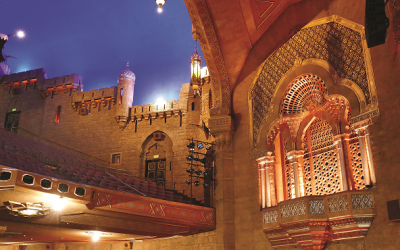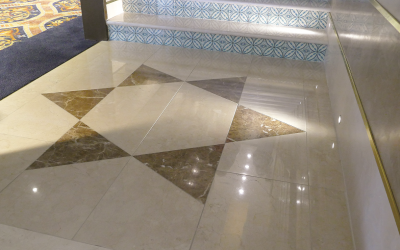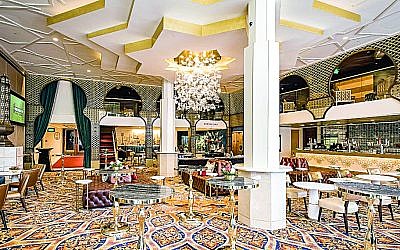Making Simcha Magic Since 1929
The Fox Theatre is one of Jewish Atlanta's most historic, beloved buildings.
Sarah Moosazadeh is a staff writer for the Atlanta Jewish Times.
The word ‘magical’ is often used to describe the historic Fox Theatre’s life-like sky ceiling, exotic ballrooms and Middle Eastern architecture. It’s also perhaps why caterer Affairs to Remember partnered with the venue several years ago and now manages all its private events.
Today, the Fox Theatre draws audiences for various shows from Broadway musicals to rock concerts, but few know how the building overcame debt, foreclosure, demolition and a fire to become one of Atlanta’s most beloved and historic buildings.
To gain a better understanding of the theater’s history, the AJT was invited by Affairs to Remember for a VIP tour led by Lauralyn Mustaki, the caterer’s director of business development at the Fox.
Enchanted by arabesque minarets, intricate designs and onion domes, Shriners from the Yaarab Shrine Temple in Atlanta sought a mosque-style structure for its headquarters that resembled the ancient temples of the Far East, according to the Fox Theatre. The Shriners eventually purchased some property on Peachtree Street and broke ground in 1928.

To help finance the building, the Shriners launched a campaign that raised $1 million in 25 days. Yet no sooner had the project launched, led by architect Ollivier Vinour of the firm Marye, Alger & Vinour, than it began to experience financial woes.
Already over budget and past deadline, the Shriners eventually received aid from Jewish theater mogul William Fox, who, alongside his wife, Eve, finished constructing the building. Eve put herself in charge of the theater’s decorating and is known for her hallmark Magen David, which is incorporated throughout the theater’s seats, carpeting and ceiling. The Fox contains 96 stars, of which a third of them twinkle.
The theater opened its doors on December 25, 1929, to a sold-out crowd, showing “Steamboat Willie,” Disney’s first cartoon starring Mickey Mouse. It took Fox 18 months to complete the project, for which he signed a 21-year lease at $100,000 a year. Today the more than $3 million project would cost $300 million to construct, Mustaki said.
Yet the theater’s success was short-lived as the great depression hit. The building hit the courthouse steps for $75,000 before theater operators Arthur Lucas and William Jenkins, in a partnership with Paramount Pictures known as Mosque Inc., picked it up for $750,000.

For the next three decades, the Fox experienced prosperity, mostly because of the Egyptian Ballroom, which was converted to a dance hall. The stars on the ballroom’s ceiling reflect the lost pharaohs, which also continue on the carpet, representing the Nile River.
But by the ‘70s the theater’s success plummeted once again as Atlantans moved to the suburbs. “People were going to drive-ins and regular AMC movie houses.
“They weren’t coming down to the Fox as they were to those shows,” Mustaki said. Television also contributed to the theater’s decline, said Travis Taylor, Affairs to Remember’s communications director.
The theater experienced even more tumultuous times after it began showing a series of horror movies, and Southern Bell sought to demolish the building in the hopes of creating a parking lot for its headquarters. But the Fox is a National Historic Landmark, one of the most ornate movie palaces remaining in the country, and one of the largest movie theaters ever built, at 250,000 square feet, according to the U.S. National Parks Service.
When Atlantans caught whiff of the news, they launched the “Save the Fox” campaign in 1974. Donors were able to raise $2 million to pay part of the $5 million tax bill, and with help from lawyers, the theater was eventually converted to a nonprofit, which reduced the amount.
Of the $30 million the Fox generates in revenue, a majority is used for restoration and preservation, Mustaki said. Most of the furniture in the building is original. Among the most renowned features of the theater is Mighty Mo, the Möller Theatre 3,622-pipe organ, among the largest in the world. Joe Patten, known as the Phantom of the Fox because he lived at the theater, took 30 years to restore the organ. He died in 2016.

The Fox has about 300 shows a year. “A lot of people have seen the Fox, but they kind of forget what we have here … when we bring them on stage, their mouth just drops. There is just not another place like it. It really is such a magical place,” Mustaki said.
To help preserve that magic, on May 18, the Fox opened the Marquee Club for subscribers and corporate members. It was the former home of the jazz club Churchill Grounds. The $10 million renovation carries much of the theater’s arabesque décor, which includes lighting from Dubai as well as a continuation of the Magen David design and gold leaf details. The upscale venue and its rooftop, complete with lounges and bars, will have some dates in December available for private events.




comments